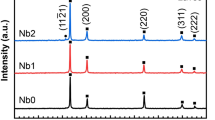Abstract
The anodic behaviour of Cu–xNi alloys and Cu and Ni metals was studied in slightly alkaline solutions containing Cl−-ions in the concentration range from 0.01 to 2.0moldm−3. The morphology and composition of the surface films formed by anodic polarization were analysed by scanning electron microscopy (SEM) and energy dispersive X-ray spectroscopy (EDS). On the basis of quasi-potentiodynamic polarization data, Ec against cNaCl diagrams were constructed, where Ec is the critical pitting potential. These diagrams allow the determination of areas where the materials are susceptible to localized pitting attack. A critical chloride concentration (ccrit) exists below which the resistance to localized corrosion increases with decreasing nickel content and above which it increases with increasing nickel content. This effect is connected with the change in the corrosion resistance observed for the pure metal constituents, i.e., copper and nickel as a function of chloride concentration. The kinetic parameters of pitting corrosion of Cu–xNi alloys reflect the specific properties of both elements and suggest that an increase in Ni content above 40% would not have a significant effect on the corrosion resistance of Cu–xNi alloys.
Similar content being viewed by others
References
R. G. Blundy and M. J. Pryor, Corros. Sci. 12 (1972) 65.
R. F. North and M. J. Pryor, Corros. Sci. 10 (1970) 297.
H. Shih and H. W. Pickering, J. Electrochem. Soc. 134 (1987) 1949.
A.-M. Beccaria and J. Crousier, Br. Corros. J. 24 (1989) 49.
C. Kato, B. G. Ateya, J. E. Castle and H. W. Pickering, J. Electrochem. Soc. 127 (1980) 1897.
J. M. Popplewell and R. J. Hart, J. A. Ford, Corros. Sci. 13 (1973) 295.
R. Gasparini, C. Della Rocca and E. loannilli, Corros. Sci. 10 (1970) 157.
F. L. LaQue, J. Am. Nav. Engrs. 53 (1941) 29.
J. H. Sinfelt, J. L. Carter and D. J. C. Yates, J. Catal. 24 (1972) 283.
M. M. Jakšić, Electrochim. Acta 29 (1984) 1539.
K. Lohrberger and P. Kohl, Electrochim. Acta 29 (1984) 1557.
H. Ezaki, M. Morinaga S. Watanabe and J. Saito, Electrochim. Acta 39 (1994) 1769.
I. Milošev and Metikoš-Huković, J. Electrochem. Soc. 138 (1991) 61.
Idem, Corrosion 48 (1992) 185.
M. Metikoš-Huković and I. Milošev, J. Appl. Electrochem. 22 (1992) 448.
H.-D. Speckmann, M. M. Lohrengel, J. W. Schultze and H.-H. Strehblow, Ber. Bunsenges. Phys. Chem. 89 (1985) 392.
H.-H. Strehblow and B. Titze, Electrochim. Acta 25 (1980) 839.
S. M. Abd El Halee and B. G. Ateya, J. Electroanal. Chem. 117 (1981) 309.
M. R. G. de Chialvo, S. L. Marchiano and A. J. Arvia, J. Appl. Electrochem. 14 (1984) 165.
Author information
Authors and Affiliations
Rights and permissions
About this article
Cite this article
Milošev, I., Metikoš-huković, M. Effect of chloride concentration range on the corrosion resistance of Cu–xNi alloys. Journal of Applied Electrochemistry 29, 393–402 (1999). https://doi.org/10.1023/A:1003426701670
Issue Date:
DOI: https://doi.org/10.1023/A:1003426701670




